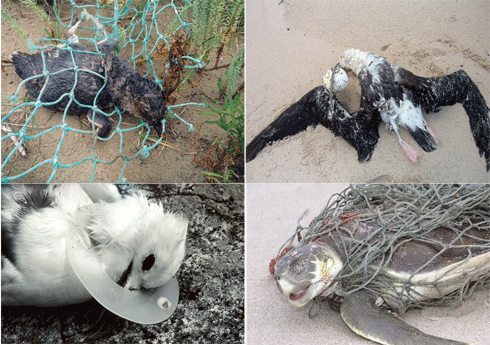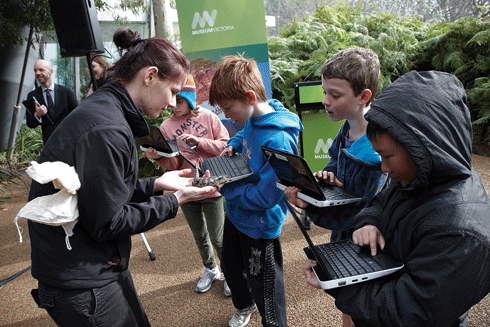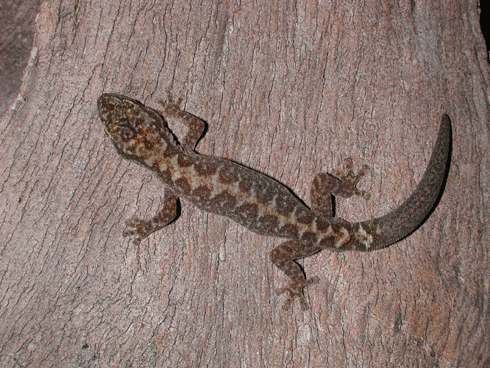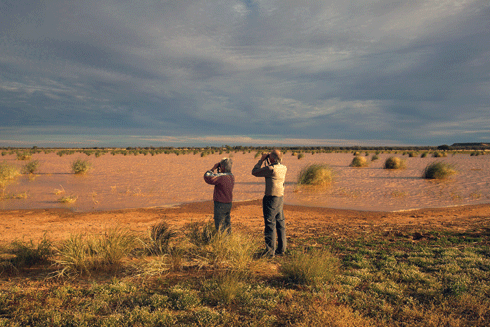
|
Published: 25 October 2010
Oceans – time to take out the garbage
People may be familiar with images of individual marine animals and birds killed by discarded plastic bags and fishing lines. But the debilitating effects of marine debris on entire species is an urgent environmental issue in the International Year of Biodiversity, as Christine Williams discovered.
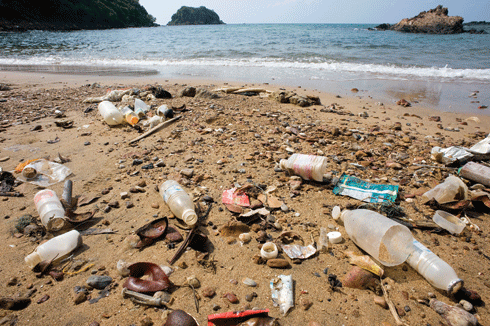
|
|
|
When the Plastiki – a boat made of 12 500 plastic bottles – arrived in Sydney in July, it alerted Australians to the impact of refuse on our oceans and sea life. In a statement congratulating the Plastiki crew, the United Nations Environment Programme (UNEP) noted that marine debris kills 100 000 turtles and other marine animals – dolphins, whales and seals – each year.
The UNEP statement also noted that if we collectively continue using the sea as a dustbin, ‘human beings will soon have turned the once beautiful and bountiful marine environment from a crucial life-support system into a lifeless one’.
Ms Kim McKay, from Momentum 2 and the Sydney Institute of Marine Science Foundation, says the issue of marine debris has been a driver in her life since 1989, when she co-founded Clean Up Australia – now a worldwide movement – with Ian Kiernan.1
‘The sad thing about the Plastiki voyage was that they didn’t see many fish. They only caught four fish during the entire voyage,’ she says.
Where does all the rubbish come from? Shipping is an obvious source. A UNEP report published in April 2009 cites a need for international agreements through national regulations for ‘reception facilities for ship-generated wastes (including damaged fishing gear and nets) [and] cooperative action within the fishing sector to prevent abandonment and discarding of old fishing gear’.2 A lot of rubbish also comes from unsustainable land-based waste disposal practices such as throwing away plastic water bottles.
Mr Doug Woodring, from Project Kaisei – a collaborative research initiative established to identify the scale of marine debris and its impact on the marine environment – says the project’s mission is to prevent the increase of marine debris, to collect it sustainably, and to enable its conversion into recyclable energy.3
The project’s current research is focused on the North Pacific, where one of five major gyres in the world spins a widening spiral of rubbish, estimated to be many thousands of square kilometres in size. Mr Woodring believes up to 80 per cent of ocean debris originates from land pollution.
‘Governments have an obligation to use better practices to prevent this pollution, for example, when land waste products pour into the sea from river mouths during rainstorms,’ he says. ‘A solution to the problem lies in enforcing national laws, so polluters are fined if they flout laws that reflect moral and societal responsibilities. The way the laws of the sea are written means there’s a focus on national boundaries and ocean-related business such as shipping lanes, industrial spills and fishing.’
Mr Woodring and his team – based in California and Hong Kong – are instead encouraging an international approach to tackling the problem of marine debris, with community engagement at the local level.
Plastic bags constitute a particular problem, as seals and other mammals can mistake them for jellyfish and consume them. Other plastics break down into small edible pieces, and the toxicology of their breakdown is little understood.
Having found plastic at depths of 200 metres during last year’s expedition, the Project Kaisei team tested for chemical toxicity on molluscs and other sea life. This year, the team sent a vessel to verify modelling of where debris collects within the gyre. This required tracking thousands of GPS-equipped buoys.
Mr Woodring hopes plastic marine debris might be harvested using ‘passive’ systems such as nets and booms, while ‘ghost nets’ might be recovered through a reward system encouraging fishers to bring back nets to shore for waste-to-energy programs, which already happens to a small extent in the United States and Korea.
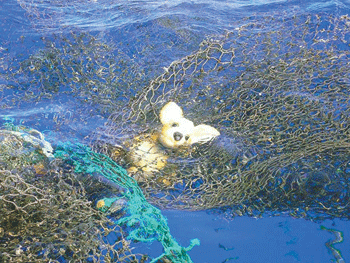
|
|
The startling form of a toy dog stares out from a tangle of ghost nets in the ‘Great Pacific Garbage Patch’. Credit: Project Kaisei
|
According to a 2009 report on the impact of plastic debris on Australian marine wildlife, most records of impacts of plastic debris on wildlife relate to ‘entanglement rather than ingestion’.4 However, the report’s author acknowledges that ‘the rate of ingestion of plastic debris by marine wildlife is difficult to assess as ... [ingestion] may not be recorded where it is not considered as the primary cause of death’.
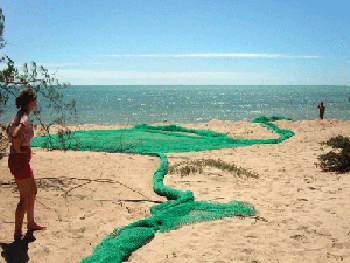
|
|
It took 13 people a full day to dig out this ghost net as part of an annual green turtle tagging program on Cobourg Peninsula, northern Australia. Credit: G. McFarlane/CVA
|
The report cites 77 species impacted by entanglement or ingestion of plastic debris since 1974. These include six species of marine turtle, 12 of cetacean, at least 34 species of seabirds, six of pinnipeds (seals), at least 10 of sharks and rays, and dugongs. The report called for a national database to be established on the impacts of plastics on marine wildlife.
Dr Jennifer Lavers, who currently works at CSIRO, has studied flesh-footed shearwaters on World Heritage-listed Lord Howe Island. She says seabirds ingest plastic after mistaking it for food. This has been linked to population declines, including the shearwaters on Lord Howe, where the number of breeding pairs has declined by more than 60 per cent since the late 1970s.
‘Chicks remain in the nest for 90 days, and it’s during this time that the parent birds ingest plastic, and then download it to their offspring,’ Dr Lavers says.
‘In a number of seabird species, chicks containing large plastic loads were found to be significantly lighter and in poorer body condition compared with chicks who were fed less plastic by their parent, so their chance of survival during the first crucial year at sea was likely to be a lot lower.
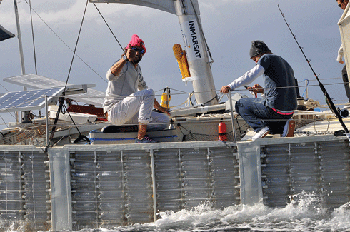
|
|
The Plastiki drew media attention to the problem of plastic pollution in the oceans during its voyage to Sydney this year. Credit: Plastiki
|
‘On Lord Howe, up to 90 per cent of flesh-footed shearwater chicks were found to have plastic in their stomachs. This plastic has resulted in ulcers, rupturing of the digestive tract, and contamination of the bloodstream with toxins such as mercury and arsenic, which are used in the plastic manufacturing process.’
Dr Lavers is seeking funding from individuals and corporate bodies interested in investing in seabird conservation and marine debris research in Australia.
Mr Jonathon Larkin from WWF Australia is concerned about the far-reaching effects of the North Pacific gyre, but acknowledges that the solution to the problem lies much nearer to home.
‘Marine debris doesn’t become an Australian government issue until it reaches Commonwealth waters, and I know of no international efforts to collect marine debris at sea,’ he says. ‘WWF strongly believes that we need to stop the rubbish getting into the ocean in the first place. Reducing the amount of disposable plastic (eg shopping bags, water bottles, food containers) that we consume is vital.’
A number of volunteer organisations based in remote areas and urban centres have been attempting to deal with problems created by the excessive amount of rubbish on Australian beaches and bays under the National Marine Debris Initiative.
Oceancare’s Tangaroa Blue works in partnership on the National Marine Debris Initiative with the Surfrider Foundation, an organisation that arose out of surfers’ concerns about the state of the oceans.
|
Research studies of marine debris are being carried out by hundreds of organisations – both government and volunteer – along many parts of the Australian coastline. Enough data has now been collected to recognise the severity of the problem – one which the UN has estimated will cost Australia more than $US6.5 million per annum to clean up. |
A few examples highlight the scope and intensity of the problem: |
The breaking down of plastic since its introduction into common use in societies all over the world, beginning in the 1950s, is perhaps the most pressing issue still to be tackled in an effective, globally collaborative way |
A UN research program estimates that 46 000 pieces of plastic are present in every square mile of ocean |
More than 7 million tonnes of human debris enter the ocean each year, with 8 million pieces of litter entering every day |
Australia’s Gulf of Carpentaria is a virtual cul-de-sac of marine rubbish, especially ‘ghost nets’ – fishing nets cut adrift from trawlers, which go on to entangle sea and birdlife with shocking consequences. |
Ms Kristy Theissling, General Manager of Surfrider, spent time with a crew collecting 9500 pieces of rubbish at 12 locations off Port Davey in the remote seas of southern Tasmania in April last year.
‘Seventy-five percent of the rubbish had originated from the fishing industry – bait straps, boxes and fishing lines, including four gill nets (fine filament nets, now illegal) – but we also found the odd item such as a child’s potty. Whereas at Cape Kimberley in the Daintree in July this year, we collected oil drums, tyres, cushions, furniture – and light globes, which we find everywhere, mostly intact,’ she says.
On the shore of the Gulf of Carpentaria, a concentrated effort is bringing some positive results, with about 100 ‘ghost nets’ collected last year over a stretch of up to 100 kilometres of shoreline. The nets are treacherous, first enmeshing fish and birds, then sea mammals such as seals, dolphins and sea turtles seeking feed.
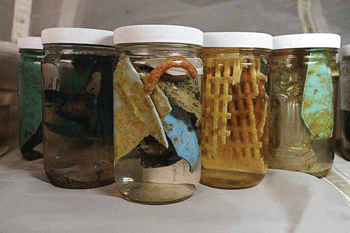
|
|
Samples of the different types of plastic collected on the 2009 Kaisei expedition to the Pacific. Credit: Project Kaisei
|
Ms Vanessa Drysdale, Sea Country Facilitator for the Dhimurru Aboriginal Corporation, says that during its annual marine debris cleanup along four kilometres of beach at Cape Arnhem last year, a group found more than ‘a tonne of rubbish such as plastic bottles (1800), footwear including thongs (2000), toothbrushes (100), rope and buoys (130)’. The total haul was more than 7700 items. The rubbish collection is part of the initiative to clean up the Indigenous Protected Area under an ‘all of us together looking after country’ conservation charter.
Conservation Volunteers Australia (CVA) organises marine debris surveys across key coastal areas of Australia, including the annual Cobourg Peninsula initiative, which it has run over the past five years.5
CVA’s Ms Joanne Davies says the volunteers who take part come from other states and overseas, paying just over $600 for the privilege of picking up rubbish in outstandingly beautiful remote country.
Mr Rod Collier, who led two groups of volunteers into the Top End – to Cobourg Peninsula in June this year, and Brown Point in the Garig Gunak Barlu National Park in August – hopes there are some signs of improvement.
‘At Wilgi near Cobourg last year, we found a couple of hundred feet of fishing net and about 100 black buoys, whereas this year we found one net too big to get out of the water, and picked up about 30 feet of net, and no buoys at all,’ he says.
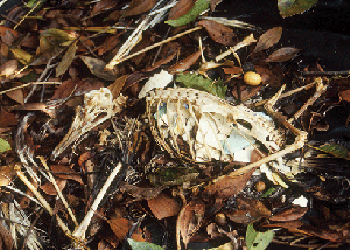
|
|
A flesh-footed shearwater found on Lord Howe island, literally choked and poisoned to death by plastic debris. Credit: I. Hutton/J.Lavers
|
The CVA team uses colour, size of mesh and size of twine to identify nets from a book provided by WWF. The identities of fishing nets and details of other debris found are documented and sent to WWF for recording. Although most fishing nets are now manufactured in China, they might have been used by Australian prawn trawlers or fishing boats from anywhere in Asia.
Ms Heidi Taylor, from Tangaroa Blue Ocean Care Society, says different areas are impacted by different types of debris, but plastics are the most common items found.
‘The problem that is becoming more and more obvious is the breaking down processes that occur with plastics,’ she says.6 ‘There are not many animals or birds that could ingest a plastic water bottle, but over time that plastic bottle breaks down into countless smaller pieces.’
Other dangerous items include six-pack rings and other small plastic rings and packing tape.
‘We only see the small percentage of what washes up, or is left on the Australian coastline from those sites that are monitored,’ Ms Taylor explains.
She says that in south-west Western Australia, beach clean ups conducted in 2008 and 2009 showed the density of debris had increased by 23 per cent.
‘While volunteers contribute many hours and a huge amount of effort to keep their coastline clean, the continued flow of marine debris onto a beach can be disheartening. We believe that consumers, manufacturers and government must all work towards a common goal of reducing the amount of waste and packaging.
‘Do people actually notice the excess packaging? Creating a link to excess packaging, rubbish and the poor turtle with a bag in its stomach is a key message so people understand the long term impacts of their behaviour.’
1 Ian Kiernan, AO, was an early advocate for cleaning up oceans after he saw the famous Sargasso Sea littered with rubbish in the 1980s. See Williams C (2006). Green Gurus: Environmentalists Who Have Changed the Face of Australia. p. 100. Lothian, Melbourne. Kim McKay, AO, is currently Chair of the ECOS Editorial Advisory Board and Director of Momentum 2, a ‘social and sustainability marketing and communications’ company.
2 UNEP (2009). Marine Litter: A Global Challenge. p. 14. UNEP, Nairobi.
3 Project Kaisei is funded by a number of organisations, including the Scripps Institution of Oceanography at UC San Diego. www.projectkaisei.org
4 Ceccarelli DM (2009). Impacts of Plastic Debris on Australian Marine Wildlife. C&R Consulting, Brisbane.
5 www.conservationvolunteers.com.au
6 www.oceancare.org.au


